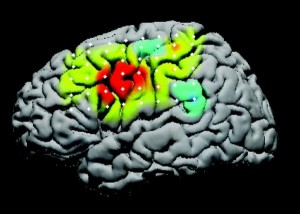 “Harnessing brain signals to control keyboards, robots or prosthetic devices is an active area of medical research. Now a rare peek at a human brain hooked up to a computer shows that the two can adapt to each other quickly, and possibly to the brain’s benefit.”
“Harnessing brain signals to control keyboards, robots or prosthetic devices is an active area of medical research. Now a rare peek at a human brain hooked up to a computer shows that the two can adapt to each other quickly, and possibly to the brain’s benefit.”
UW CSE’s Raj Rao, his grad student Kai Miller, and a team of researchers looked at signals on the brain’s surface while using imagined movements to control a cursor. Electrodes attached to the surface of the human brain show that imagining movements to control a computer cursor generates larger-than-life brain signals in less than 10 minutes of training.
“People have been looking at imagined movements as a way to control computers for a long time. This study provides a glimpse of the underlying neural machinery,” said Rao.
Read the full paper in the Proceedings of National Academy of Sciences here.
Read the UWeek article here.

